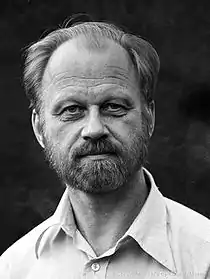Jürgen Moser
Jürgen Kurt Moser (July 4, 1928 – December 17, 1999) was a German-American mathematician, honored for work spanning over four decades, including Hamiltonian dynamical systems and partial differential equations.
Life
Moser's mother Ilse Strehlke was a niece of the violinist and composer Louis Spohr. His father was the neurologist Kurt E. Moser (July 21, 1895 – June 25, 1982), who was born to the merchant Max Maync (1870–1911) and Clara Moser (1860–1934). The latter descended from 17th century French Hugenot immigrants to Prussia. Jürgen Moser's parents lived in Königsberg, German empire and resettled in Stralsund, East Germany as a result of the second world war. Moser attended the Wilhelmsgymnasium (Königsberg) in his hometown, a high school specializing in mathematics and natural sciences education, from which David Hilbert had graduated in 1880. His older brother Friedrich Robert Ernst (Friedel) Moser (August 31, 1925 – January 14, 1945) served in the German Army and died in Pillkallen/Schloßberg (East Prussia).
Moser married the biologist Dr. Gertrude C. Courant (Richard Courant's daughter, Carl Runge's granddaughter and great-granddaughter of Emil DuBois-Reymond) on September 10, 1955 and took up permanent residence in New Rochelle, New York in 1960, commuting to work in New York City. In 1980 he moved to Switzerland, where he lived in Schwerzenbach near Zürich. He was a member of the Akademisches Orchester Zürich. He was survived by his younger brother, the photographic printer and processor Klaus T. Moser-Maync from Northport, New York, his wife, Gertrude Moser from Seattle, their daughters, the theater designer Nina Moser from Seattle and the mathematician Lucy I. Moser-Jauslin from Dijon, and his stepson, the lawyer Richard D. Emery from New York City. Moser played the piano and the cello, performing chamber music since his childhood in the tradition of a musical family, where his father played the violin and his mother the piano. He was a lifelong amateur astronomer and took up paragliding in 1988 during a visit at IMPA in Rio de Janeiro.
Work
Moser completed his undergraduate education at and received his Ph.D. from the University of Göttingen in 1952, studying under Franz Rellich. After his thesis, he came under the influence of Carl Ludwig Siegel, with whom he coauthored the second and considerably expanded English language edition of a monography on celestial mechanics. Having spent the year 1953 at the Courant Institute of New York University as a Fulbright scholar, he emigrated to the United States in 1955 becoming a citizen in 1959.[1] He became a professor at MIT and later at New York University. He served as director of the Courant Institute of New York University in the period of 1967–1970. In 1970 he declined the offer of a chair at the Institute for Advanced Study in Princeton. After 1980 he was at ETH Zürich, becoming professor emeritus in 1995. He was director (sharing office with Armand Borel in the first two years) of the Forschungsinstitut für Mathematik at ETH Zürich in 1984–1995, where he succeeded Beno Eckmann. He led a rebuilding of the ETH Zürich mathematics faculty. Moser was president of the International Mathematical Union in 1983–1986.
Students
Among Moser's students were Mark Adler of Brandeis University, Ed Belbruno, Charles Conley (1933–1984), Howard Jacobowitz of Rutgers University, and Paul Rabinowitz of University of Wisconsin.
Awards and honours
Moser won the first George David Birkhoff Prize in 1968 for contributions to the theory of Hamiltonian dynamical systems, the James Craig Watson Medal in 1969 for his contributions to dynamical astronomy, the Brouwer Medal of the Royal Dutch Mathematical Society in 1984, the Cantor Medal of the Deutsche Mathematiker-Vereinigung in 1992 and the Wolf Prize in 1995 for his work on stability in Hamiltonian systems and on nonlinear differential equations. He was elected to membership of the National Academy of Sciences in 1973 and was corresponding member of numerous foreign academies such as the London Mathematical Society and the Akademie der Wissenschaften und Literatur, Mainz . At three occasions he was an invited speaker at the quadrennial International Congress of Mathematicians, namely in Stockholm (1962) in the section on Applied Mathematics, in Helsinki (1978) in the section on Complex Analysis,[2] and a plenary speaker in Berlin (1998).[3] In 1990 he was awarded honorary doctorates from University of Bochum and from Pierre and Marie Curie University in Paris. The Society for Industrial and Applied Mathematics established a lecture prize in his honor in 2000.
Notes
- "Jurgen Kurt Moser". U.S. Naturalization Records Indexes, 1794–1995. Ancestry.com. Retrieved June 12, 2011.
Name: Jurgen Kurt Moser; Age: 31; Birth Date: 4 Jul 1928; Issue Date: 2 Feb 1959; State: Massachusetts; Locality, Court: District of Massachusetts, District Court
(subscription required) - Moser, J. (1979). "The holomorphic equivalence of real hypersurfaces". Proceedings of the International Congress of Mathematicians (Helsinki, 1978). pp. 659–668.
- Moser, Jürgen (1998). "Dynamical systems — past and present". Doc. Math. (Bielefeld) Extra Vol. ICM Berlin, 1998, vol. I. pp. 381–402.
References
- Mather, John N.; McKean, Henry P.; Nirenberg, Louis; Rabinowitz, Paul H. (December 2000). "Jürgen K. Moser" (PDF). Notices of the AMS. 4 (11): 1392–1405. Retrieved 2007-08-20.
- J.J. O'Connor; E. F. Robertson. "Jürgen Kurt Moser". Retrieved 2008-07-04.
- Sylvia Nasar (December 21, 1999). "Obituary, New York Times". The New York Times. Retrieved 2010-09-14.
- American Institute of Physics. "Professional biography Jürgen Moser". Archived from the original on 2012-10-05. Retrieved 2010-12-05. Cite journal requires
|journal=(help) - Vladimir Arnold. "Déclin des Mathématiques (après la mort de Jürgen Moser)" (PDF). Retrieved 2012-10-11. Cite journal requires
|journal=(help) - ETH (20 March 2002). "Biography of Jürgen Moser, by ETH". ETH. Retrieved 2013-04-02.
- Guardian (20 March 2000). "Obituary of Moser, by Guardian". The Guardian. Retrieved 2013-05-27.
- SIAM (20 April 2001). "Moser Lecture, by SIAM". Retrieved 2013-11-16.
- Max Planck Institut Leipzig (31 May 2001). "In memoriam Jürgen Moser". Moser Symposium, by MPI Leipzig. Retrieved 2013-11-16.
